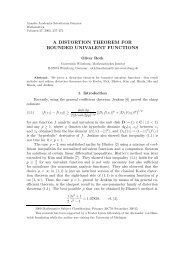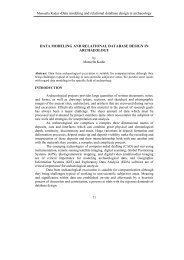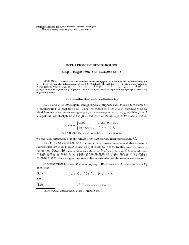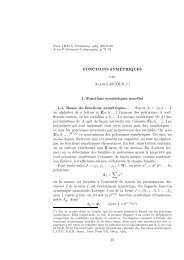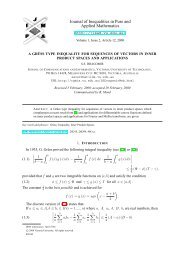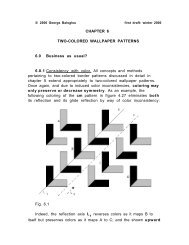SUPERNOMIAL COEFFICIENTS, BAILEY'S LEMMA AND ROGERS ...
SUPERNOMIAL COEFFICIENTS, BAILEY'S LEMMA AND ROGERS ...
SUPERNOMIAL COEFFICIENTS, BAILEY'S LEMMA AND ROGERS ...
You also want an ePaper? Increase the reach of your titles
YUMPU automatically turns print PDFs into web optimized ePapers that Google loves.
2 S. O. WARNAARWe should remark here that this paper does not in any way discuss the A n−1Bailey lemma of Milne and Lilly [28, 29], nor the A n−1 Rogers–Ramanujanidentities of Milne [26, 27]. It is our current believe that the A 2 Bailey lemmafor supernomials and the A 2 case of Milne and Lilly’s lemma are generalizationsof the classical A 1 Bailey lemma, which, in a sense, are orthogonal. Also theA 2 Rogers–Ramanujan identity of this paper appears to be unrelated to theA 2 case of Milne’s A n−1 Rogers–Ramanujan identity.2. A 1 Rogers–Ramanujan-type identitiesThe Gaussian polynomial or q-binomial coefficient is defined as⎧[ n⎨ (q) nfor 0 ≤ m ≤ n= (q) m (q) n−mm]⎩0 otherwise,where (a; q) ∞ = (a) ∞ = ∏ ∞k=0 (1 − aqk ) and(a; q) n = (a) n =(a) ∞(aq n ) ∞, n ∈ Z.In particular, (q) 0 = 1, (q) n = (1 − q) . . . (1 − q n ) and 1/(q) −n = 0 for n ≥ 1.We will often use a shifted and normalized q-binomial coefficient, defined as⎧S(L, k) = 1 [ ] 2L⎨ 1for − L ≤ k ≤ L(2.1)= (q) L−k (q) L+k(q) 2L L − k ⎩0 otherwise.By the q-Chu–Vandermonde summation (equation (3.3.10) of [3]), it followsthat the modified q-binomial satisfies the following “invariance property”(equation (13) of [31] with c k = δ k,r ) ,(2.2)M∑L=0q L2 S(L, r)(q) M−L= q r2 S(M, r).That is, the modified q-binomial is (up to an overall factor) invariant undermultiplication by q L2 /(q) M−L followed by a sum over L. It is this property ofthe q-binomial that we shall try to generalize to other q-functions.First, however, let us demonstrate the effectiveness of the result (2.2) inderiving identities of the Rogers–Ramanujan type. To obtain identities for oddmoduli our starting point is the following specialization of the the q-binomialformula (equation (II.4) of [15]),(2.3)L∑(−1) r q (r 2) S(L, r) = δL,0 ,r=−L


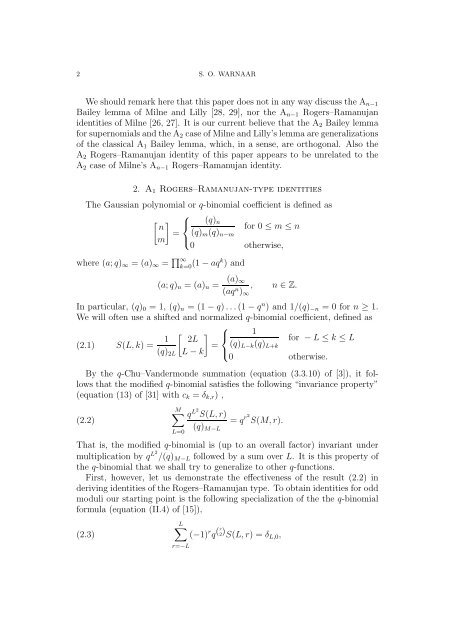
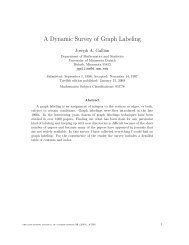


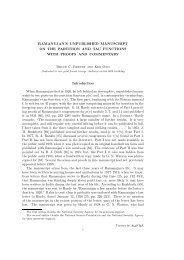
![(.,t ] and [s, .) , where [s,t ] = {s' GT; s ¤ s' ¤ t} , (.,t ] = {s' GT; s' ¤ t} and ...](https://img.yumpu.com/43303393/1/184x260/t-and-s-where-st-s-gt-s-a-s-a-t-t-s-gt-s-a-t-and-.jpg?quality=85)


